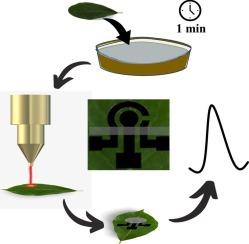基于CO2激光热解绿叶的多菌灵可持续电化学传感器
IF 4.9
2区 化学
Q1 CHEMISTRY, ANALYTICAL
引用次数: 0
摘要
使用绿叶作为电化学传感器生产的衬底是传统材料的可持续和创新的替代品。此外,CO2激光热解有助于在各种衬底上制造电极,促进高性能,环保和经济高效的传感器。在这项工作中,我们使用大叶杉树(S. macrophylla)的绿叶作为传感器的底物,这是一种在巴西丰富且易于获取的树种。为此,我们调整了激光切割的距离、功率、速度等参数,以改善分析信号。在电化学测量中,为了提高性能和稳定性,用0.3 mol L−1的柠檬酸钠处理叶片。通过电化学和形态分析对该传感器进行了表征。提出的传感器应用于多菌灵(CBZ),多菌灵是一种杀菌剂,可以保护植物免受真菌疾病的侵害,并对人类造成包括癌症在内的健康风险。该传感器在0.5 ~ 10 μmol L−1的线性范围内,检测限为0.1 μmol L−1。对自来水、橙汁和蜂蜜进行了添加和回收试验,结果表明CBZ的含量在90.6% ~ 101.1%之间。该研究表明,由脱水绿叶制成的电化学传感器具有有效的分析性能,高重复性和可再现性,突出了它们作为传统传感器基材的可持续替代品的潜力。本文章由计算机程序翻译,如有差异,请以英文原文为准。

Sustainable electrochemical sensor from CO2 laser pyrolyzed green leaves for carbendazim detection
The use of green leaves as a substrate for electrochemical sensor production is a sustainable and innovative alternative to conventional materials. Also, CO2 laser pyrolysis facilitates electrode fabrication on various substrates, promoting high-performance, eco-friendly, and cost-effective sensors. In this work, we used the green leaf as a substrate for sensors from S. macrophylla, a tree species that is abundant and easily accessible in Brazil. For this purpose, we adjusted the laser cutting parameters such as distance, power, and speed to improve the analytical signal. For the electrochemical measurements, the leaves were treated with 0.3 mol L−1 sodium citrate to improve performance and stability. This electrochemical sensor was characterized through electrochemical and morphological analysis. The proposed sensor was applied for Carbendazim (CBZ), a fungicide that protects plants from fungal diseases and poses health risks, including carcinoma, in humans. For this analyte, the sensor presented a linear range of 0.5 to 10 μmol L−1, with a detection limit of 0.1 μmol L−1. CBZ was detected by using addition and recovery tests in tap water, orange juice, and honey, and the values varied from 90.6 % to 101.1 %. This study demonstrates that electrochemical sensors made from dehydrated green leaves exhibit effective analytical performance, high repeatability, and reproducibility, highlighting their potential as sustainable alternatives to traditional sensor substrates.
求助全文
通过发布文献求助,成功后即可免费获取论文全文。
去求助
来源期刊

Microchemical Journal
化学-分析化学
CiteScore
8.70
自引率
8.30%
发文量
1131
审稿时长
1.9 months
期刊介绍:
The Microchemical Journal is a peer reviewed journal devoted to all aspects and phases of analytical chemistry and chemical analysis. The Microchemical Journal publishes articles which are at the forefront of modern analytical chemistry and cover innovations in the techniques to the finest possible limits. This includes fundamental aspects, instrumentation, new developments, innovative and novel methods and applications including environmental and clinical field.
Traditional classical analytical methods such as spectrophotometry and titrimetry as well as established instrumentation methods such as flame and graphite furnace atomic absorption spectrometry, gas chromatography, and modified glassy or carbon electrode electrochemical methods will be considered, provided they show significant improvements and novelty compared to the established methods.
 求助内容:
求助内容: 应助结果提醒方式:
应助结果提醒方式:


